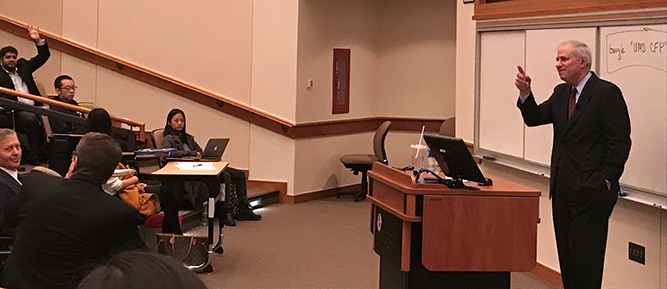
Factors and implications surrounding the financial crisis of 2008 was the focus of a recent presentation by Martin J. Gruenberg, chairman of the Federal Deposit Insurance Corporation, hosted by the Center for Financial Policy at the University of Maryland’s Robert H. Smith School of Business.
Smith Professor of Finance Haluk Ünal introduced Gruenberg to students, faculty and staff gathered in the Frank Auditorium for the Nov. 3, 2017 event, titled “The Financial Crisis and its Aftermath.”
“Impressively, Chairman Gruenberg has devoted his entire career to meaningful and significant public service,” noted Ünal, also a visiting scholar for the FDIC Division of Insurance and Research. “He had important roles in major legislative events affecting the banking industry, and these include the Financial Institutions Reform, Recovery, and Enforcement Act of 1989 (FIRREA); the Federal Deposit Insurance Corporation Improvement Act of 1991; the Gramm-Leach-Bliley Act of 1999.”
Following Ünal, Gruenberg noted two financial crises that he described as weighing significantly on his career. “I thought the ‘Thrift Crisis’ (1980-90 Savings and Loan Crisis) would be the most severe crisis I would encounter. It resulted in the failure of nearly a third of its industry and cost taxpayers nearly $140 billion to make good on the failed institutions,” he said. “But as it turned out it was a relatively a small hors d'oeuvre compared to what we went through in 2008 and 2009.”
The latter crisis “pushed us remarkably close to a catastrophic collapse of the financial system," he said. "We managed to dodge that bullet through extraordinary and unprecedented public intervention.”
The regulatory reform- and bailout-driven recovery, since 2010, has been sustainable, and “the banking industry particularly, from the large institutions to the small community banks, is doing quite well,” he said.
The 2008 crisis, he added, “surpassed” the crisis surrounding the 1930s’ Great Depression, “because our financial system today is a much larger part of the economy than it was back then and far more complex and far more interconnected, globally.”
Illustrating the complexity, and among precursors to the crisis, he pointed to the subprime mortgage meltdown triggered by the “two-year teaser rate” with its low, and subsequently ballooning, interest rate: “Lenders assumed borrowers would refinance every two years to retain the low rate… And, capturing a whole new set of fees associated with each refinancing would be lucrative for those lenders,” he added. But the tactic hinged, and failed, on housing values increasing year to year.
For other Gruenberg insights related to financial policy, visit the FDIC’s collection of Gruenberg’s “Speeches and Testimonies” transcripts.
Media Contact
Greg Muraski
Media Relations Manager
301-405-5283
301-892-0973 Mobile
gmuraski@umd.edu
About the University of Maryland's Robert H. Smith School of Business
The Robert H. Smith School of Business is an internationally recognized leader in management education and research. One of 12 colleges and schools at the University of Maryland, College Park, the Smith School offers undergraduate, full-time and flex MBA, executive MBA, online MBA, business master’s, PhD and executive education programs, as well as outreach services to the corporate community. The school offers its degree, custom and certification programs in learning locations in North America and Asia.